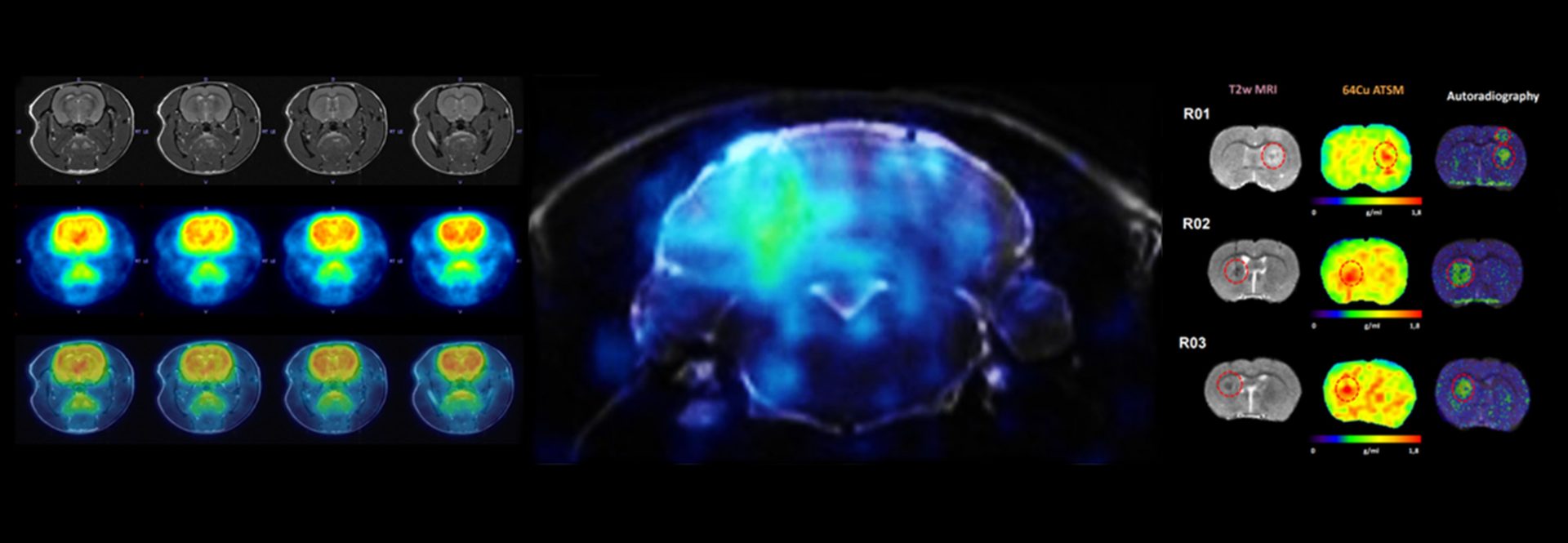Webinar Overview
Hypoxia occurs due to inadequate oxygen supply and greatly influences solid tumor development and resistance to treatment. During hypoxia, the lack of oxygen disturbs the intracellular redox balance, which becomes reductive. [64Cu]-CuATSM is a lipophilic radiopharmaceutical compound with the property of being retained in cells with high reducing potential so it can carry out a mapping of hypoxic cells using PET. PET/MRI can play a critical role in the diagnosis, treatment orientation, and subsequent management of brain tumors as it can provide complementary information regarding tumor metabolic properties, particularly when performed simultaneously with advanced MRI techniques.
In recent years, cellular hypoxia and the associated intra-cellular metabolic modifications have become a large field of study in various pathologies such as neurology, cardiology, and oncology. In vivo access to the cellular hypoxic status by direct physical methods appears to be complex and invasive. The recent rise in nuclear medicine approaches based on positron-emitting radiopharmaceuticals provides access to this information. [64Cu]-CuATSM is a lipophilic copper complex that penetrates normoxic and hypoxic cells. Normoxic cells efflux this radiopharmaceutical while hypoxic cells accumulate.
This nuclear metabolic imaging approach therefore enables non-invasive mapping of hypoxic cells.
In the specific field of oncology, intratumorally hypoxia represents a major poor independent prognostic factor and is recognized as a massive obstacle to the efficacy of conventional therapies. Hypoxia is highly heterogeneous in space and time and in a clinical environment, the tissue partial pressure in O2 (ptO2) cannot, however, be mapped. Therefore, noninvasive mapping of tumor hypoxia represents a great opportunity for diagnosis but also for treatment improvement and adaptation.
In this webinar we will show examples on how hypoxia mapping can be further used to adapt loco-regional treatment such as external radiation-therapy.
Thursday, 25 April 2024, 16:00 CET
Key Learning Topics
- Hypoxia is an important phenomenon in various pathology with large impact in disease prognosis and patient outcome. Hypoxia occurs due to inadequate oxygen supply and impaired blood flow in solid tumors, playing a crucial role in their tumor development. It can activate angiogenesis, enhance invasiveness, suppress anti-tumor immunity and hamper therapeutic responses.
- PET/MRI is a powerful tool imaging brain tumors as it can provide tumor metabolic properties. In particular, [64Cu]-CuATSM proof-of-concept in various hypoxic models will be covered.
- This webinar will cover these topics as well as showing examples on how hypoxia mapping can be further used to adapt loco-regional treatment such as external radiation-therapy.
What To Expect
During the webinar, we will first discuss the currently available methods used to detect hypoxia using both MRI and PET imaging and in particular, the [64Cu]-CuATSM metabolism and the use of this radiopharmaceutical in different preclinical and clinical pathologic models. We will provide examples of hypoxia imaging in brain tumor situations (high grade gliomas, brain metastases) in rodents and in the clinic.
Who Should Attend
This webinar will be of interest to multiple profiles in the community of biomedical research specially those applying medical imaging techniques in their work. Clinicians, researchers, PhD students and postdocs as well laboratory technicians will find this webinar relevant
Speakers
Dr Samuel Valable
Research Director
ISTCT Lab at Cyceron Research Center
Dr Samuel Valable obtained his PhD in 2004 from the University of Caen Basse-Normandie, France. After this, Samuel completed two post-doctorates in Grenoble and Caen. In 2009, he was recruited by the CNRS and joined the Imaging and therapeutic strategies for brain and tumor pathologies laboratory. Glioblastomas are the highest-grade brain tumors, and their prognosis remains very poor and Samuel's research aims to combat them through innovative therapeutic strategies. His research focuses in particular on inhibiting the formation of blood vessels around tumors and countering the effects of low oxygen availability in tumors. This state of hypoxia contributes to tumor growth and resistance to chemotherapy and radiotherapy. More generally, it relies on the use of biomedical imaging to characterize the different compartments making up these tumors and to determine the early effects of anti-tumor therapies.
Dr. Mickaël Bourgeois
Radiopharmacist –Associate Professor
Nantes University Hospital – Nuclear Medicine Department
ARRONAX Cyclotron – Radiopharmacy Unit
Dr. Mickaël Bourgeois is an associate professor and radiopharmacist (PharmD) in the nuclear medicine department of Nantes University Hospital and is head of the radiopharmacy unit at the ARRONAX cyclotron. He also works in the Nuclear Oncology research team at CRCI2NA (French institute for health and medical research). After a PhD in the field of alpha radioimmunotherapy with astatine-211, he works with other alpha emitters such bismuth-213 and actinium-225 for preclinical and clinical applications. He is particularly involved in the development of radiopharmaceutical drugs for theranostic applications in oncology. He contributed to the setting-up of 9 clinical trials in the last 5 years and he is the author of 44 publications in international peer-reviewed journals and participated to 5 book chapters in nuclear medicine field.
